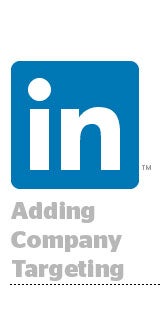 Marketers on LinkedIn have long been able to target titles like “VP of engineering” for sponsored updates and inMails. On Tuesday, LinkedIn rolled out account targeting, allowing marketers to target actual companies in their campaigns, up to 30,000 of them at a time.
Marketers on LinkedIn have long been able to target titles like “VP of engineering” for sponsored updates and inMails. On Tuesday, LinkedIn rolled out account targeting, allowing marketers to target actual companies in their campaigns, up to 30,000 of them at a time.
Wait, LinkedIn couldn’t target by company before?
“This has been one of the most requested features for years, and it comes down to prioritization,” said Penry Price, VP of marketing solutions for LinkedIn. Before, companies could use a manual hack that allowed them to target or blacklist up to a hundred companies. Other product priorities had prevented the company from automating and expanding this feature.
Now priorities are changing.
LinkedIn recently killed off its standalone “marketing suite” product, Lead Accelerator, one year after its launch. The product had been powered by technology acquired through the purchase of Bizo for $175 million.
Engineers who were supporting Lead Accelerator will begin to adapt its functionalities to support LinkedIn’s fast-growing sponsored updates business.
In the next few quarters, marketers should expect to see two other products with Bizo DNA. One will bring website analytics to LinkedIn, allowing marketers to see who engaged with content on their owned and operated sites. The second, conversion tracking for sponsored updates, will “help [marketers with] the attribution story, and understanding the quality of conversions we can drive,” Price said.
LinkedIn will also explore adding features around data onboarding (imagine the B2B version of Facebook’s popular Custom Audiences product). In some sense, account targeting is an early use case for data onboarding, since marketers can upload files of up to 30,000 businesses they want to target.
While LinkedIn is integrating many Lead Accelerator features into its core business, it’s also moving away from another product with Bizo roots, the Network Display business.
“The world of network display around the web is much more commoditized, and everyone offers it,” Price said. The product was “not taking advantage of what LinkedIn’s data had to offer and was not doing enough from a unique standpoint.”
As LinkedIn develops its marketing offerings, though, it’s worth noting that its multiple revenue streams – think the SaaS business it has around recruiting, for example – make it more hesitant to embrace certain types of advertising.
“We do have a higher bar, and we do have to think a bit differently about the commercialization of our feed,” Price said. “Even though we get asked about video all the time, we’re not going to do it without the member experience in mind. We don’t have the ability to dump a bunch of ads in the feed, and that’s a blessing, because the other revenue streams allow us to do the right thing for the member.”












